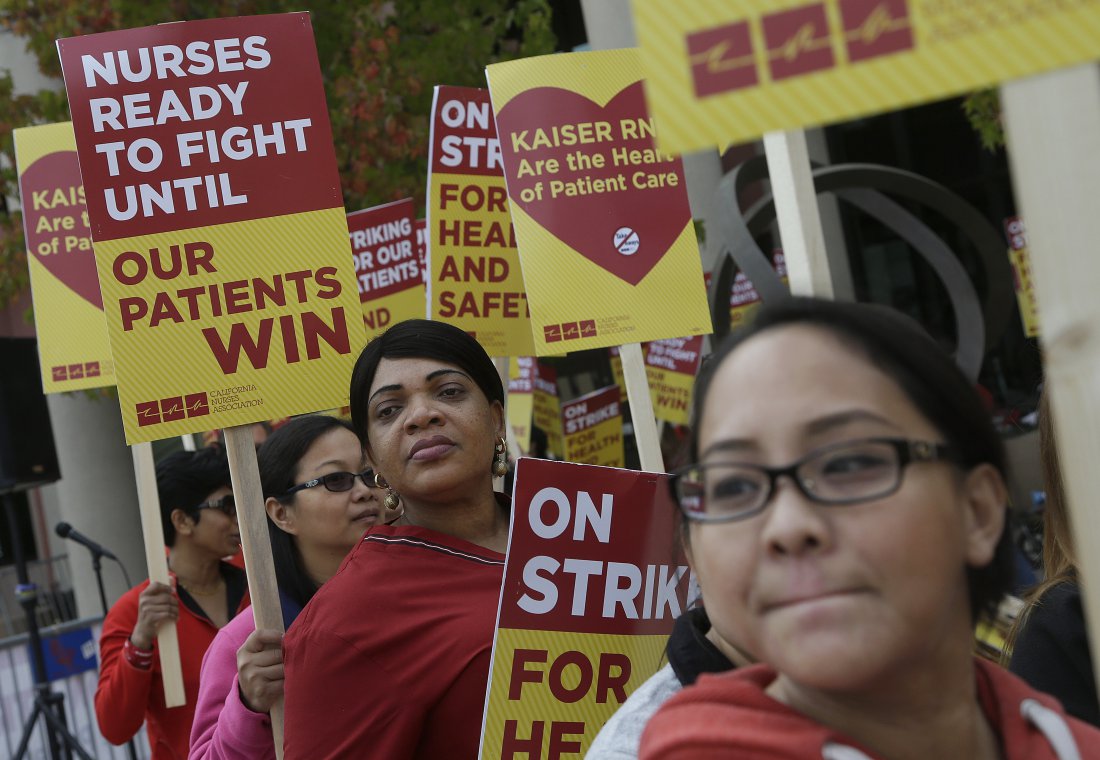Deborah Burger, co-president of the California Nurses Association, says that when she started her career as an intensive care unit nurse in the 1970s, a grocery clerk made more money than she did.
Things have changed quite a bit since then, especially in California.
Registered nurses in the Golden State earn $100,000 a year on average, more than their counterparts anywhere else in the country, according to recently-released data from the Bureau of Labor Statistics. The average hourly wage for registered nurses in California is $48.68 an hour, the 2015 data shows.
California also employs the most registered nurses — 255,010 last year. The Los Angeles-Long Beach-Glendale metropolitan area alone employs 70,810 nurses. The only other region employing more than that is New York-Jersey City.
Burger, who practices in Sonoma County, says appreciation for the value of nurses has grown over time. Their wages started rising in the early 2000s, and the female-dominated field began to see some parity with other occupations, such as law enforcement. A 1999 California law mandating specific nurse-to-patient ratios also played a role in boosting registered nurse wages.
“I think nurses themselves really started to understand that hospitals don’t function without them and they are indispensable for patient safety,” Burger says.

Registered nurses and supporters protest outside of a Kaiser Permanente facility in San Francisco, in 2014. The strength of of the nurses union is cited as one of the reasons for high wages in the state. (Jeff Chiu/AP)
Nurses in Hawaii and Massachusetts earn nearly as much as those in California, with average annual salaries of $90,000 and $88,000, respectively. The national average salary for a registered nurse is $71,000.
This makes sense, experts say, considering that living expenses in those three states are high. In addition, the nurse’s union has a strong presence in California.
Dr. Joanne Spetz, a professor at the University of California, San Francisco School of Nursing, says that despite the high statewide average, it is important to consider regional wage differences. “California is a big state and there is lots of variation,” she says.
A nurse working in Bakersfield probably isn’t making the same salary as one in San Francisco, Spetz says. Incomes of nurses on the pricey Westside of Los Angeles, and in the Bay Area, most likely drive the averages up, Spetz says.
The ten locations in the U.S. that pay the highest salaries to registered nurses are all located in California. At top are nurses in San Francisco, who earn $133,000 per year, on average. The city is also known for having the highest rents in the nation.
Other high-paying regions for California registered nurses include Santa Cruz-Watsonville, Sacramento, and Modesto.
Spetz said another reason behind the higher salaries for RNs is that California’s licensed vocational nurses — who receive less training than registered nurses — are not allowed to do as much as their counterparts in other states. For example, LVNs in California cannot administer medication through an intravenous line. This results in a higher demand for registered nurses, who are paid accordingly, Spetz says.
In 1999, California passed a law that established minimum nurse-to-patient ratios in hospitals, driving up demand for registered nurses in particular. In a 2009 study, Spetz and colleagues found that from 2000 to 2006, registered nurses in California’s urban centers saw their wages rise by as much as 12 percent more than RNs in other states.
After the implementation of the nurse-to-staff ratios, “wage growth for RNs far outstripped wage growth in other states without such legislation,” the study says.
High demand, the high cost of living and union power underlie the higher salaries of California’s registered nurses.
Burger said the nurse’s union has also played a role in assuring that nurses have access to pension plans and that they retire with health benefits. And that’s something that some non-unionized nurses still don’t receive, she says.
There’s also been a culture shift. A registered nurse’s job is no longer to simply carry out a doctor’s orders; there are more functions and responsibilities, Burger said. “We’re also now writing orders that doctors sign off on,” she said. “It’s a little bit of everything.”
This story was produced by Kaiser Health News, which publishes California Healthline, an editorially independent service of the California Health Care Foundation.




